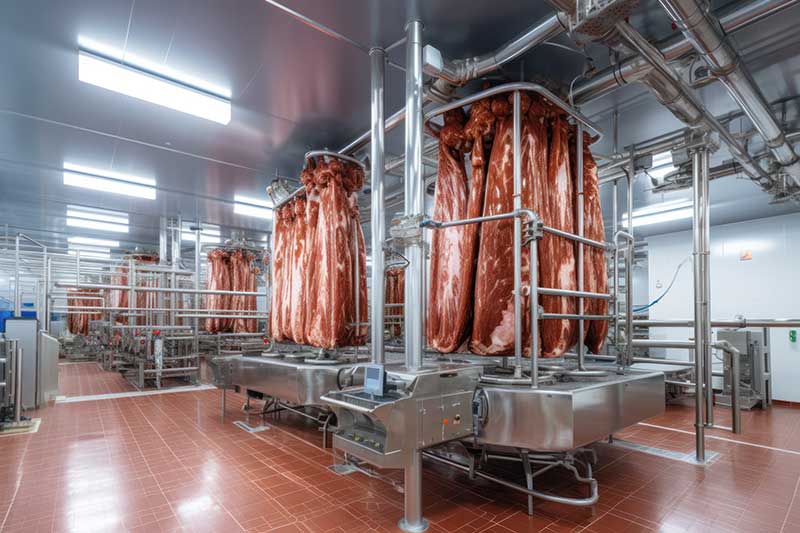The EPA is proposing new limits on nutrients and other pollutants released in wastewater from slaughterhouses and meat and poultry processing facilities. Fluence offers state-of-the-art wastewater treatment solutions that can enable industry to meet these new standards.
The federal agency presents multiple options to enhance limits on nutrient discharges into waterways
Meat and poultry products (MPP) processing facilities significantly contribute to nitrogen and phosphorus pollution in fresh water. Nutrient loading can be extremely detrimental to aquatic ecosystems, contributing to eutrophication and algal blooms that pose environmental and human health risks.
In the United States, the Environmental Protection Agency (EPA) has long established effluent guidelines for the meat and poultry products industry to limit the environmental impact of wastewater discharges from facilities involved in animal processing. These guidelines specify discharge limits for various pollutants, including biochemical oxygen demand, total suspended solids, fats, oils, and grease, and others.
In January 2024, the EPA proposed a revision to the discharge limits for nutrients and other pollutants released into freshwater systems and public wastewater treatment facilities.
Effluent Guidelines and How They Are Determined
The EPA’s Effluent Limitations Guidelines and Standards are national regulations that limit the levels of pollutants that can be discharged into waterways or public wastewater treatment systems. They are based on the efficiency of wastewater treatment technologies that can achieve the desired pollutant reduction levels, while also considering economic viability for industry stakeholders.
Because treatment technologies are constantly evolving, the EPA regularly reviews and revises these standards, thereby improving the quality of wastewater effluent discharged into freshwater systems and thus improving water quality across the nation. The MPP Effluent Guidelines were originally implemented in 1974 and were amended in 2004 and 2021.
The Meat and Poultry Products Effluent Guidelines apply to any facility that slaughters and processes livestock or poultry, renders animal waste or byproducts, or produces meat products. According to the EPA, there are around 5,000 MPP facilities in the U.S., many of which discharge their wastewater into public wastewater treatment systems, which treat and then discharge the effluent into waterways.
Overview of the Proposed EPA Regulation
The EPA’s suggested rule change includes three options, with the first one favored by the EPA and the two alternatives, which were open for public comment until March 25, 2024.
For facilities releasing wastewater directly into U.S. waters, the EPA’s preferred option would enhance the effluent standards outlined in the 1974 and 2004 regulations. This enhancement establishes stricter effluent limits to control nitrogen and introduces effluent limits for phosphorus discharge. This option would also introduce pretreatment standards for facilities with indirect discharges. The aim is to regulate pollutants such as oil and grease, total suspended solids, and biochemical oxygen demand. This regulatory option applies to around 850 of the 5,000 MPP facilities across the nation.
The two alternatives open for public input involve placing effluent limitations on more facilities with direct discharges, and introducing pretreatment standards to more facilities with indirect discharges. These two alternatives would also institute pretreatment standards for nitrogen and phosphorus in some of the indirect discharging facilities, as proposed in the preferred option.
The EPA is seeking feedback on a provision included in the proposal that would mandate the segregation and proper management of high-salt waste streams generated at certain facilities. It also proposes including E. coli bacteria in the regulated parameters for facilities discharging directly into the environment.
In the options featuring nutrient pretreatment standards for indirect dischargers, the proposal invites feedback on a component known as conditional limitations. If the EPA opts to incorporate nutrient pretreatment standards, it could streamline treatment processes for meat and poultry processors that discharge wastewater to public facilities, potentially reducing compliance costs for those with indirect discharges. By pretreating the industrial wastewater on-site and lowering the nutrient levels, processors would be charged less for treatment by the municipal plant.
Optimizing Meat-Processing Wastewater Treatment
Treating wastewater from meat processing is complex and involves a multistage treatment approach. Dissolved air flotation (DAF) is an initial step, effectively removing about 80% of the organic load and 65% of the nitrogen load by eliminating suspended particles. Subsequently, the sludge can be sent to anaerobic digestion to enhance byproduct value and create energy. This stage not only minimizes waste, but also generates biogas, predominantly methane and carbon dioxide, offering a sustainable energy source for facilities like slaughterhouses.
After anaerobic digestion, the remaining mass, known as digestate, undergoes separation based on consistency. Solid sludge, typically constituting less than 20% of the original waste stream, can be repurposed or further treated and sold as fertilizer. Liquid digestate undergoes additional processes, including potential nitrification and denitrification to meet specific standards.
To deal with increasingly strict regulation of nutrient discharges, Fluence also offers a combination of technologies that effectively address residual nitrogen and phosphorus. These include Nitro, a shortcut nitrogen method created by Fluence. Additionally, membrane aerated biofilm reactor (MABR) technology can be used to provide high-rate, low-energy nitrogen and phosphorus removal. These systems are often a great step toward achieving even stricter reuse and surface water standards such as California Title 22. MABR not only reduces wastewater treatment energy requirements, but also minimizes the necessary footprint.
Fluence’s state-of-the-art wastewater treatment solutions, including waste-to-energy technology, can turn waste into a valuable resource. Contact Fluence to learn more about the wastewater treatment solutions we offer for the meat and poultry processing industry to ensure compliance with any regulatory requirement.

